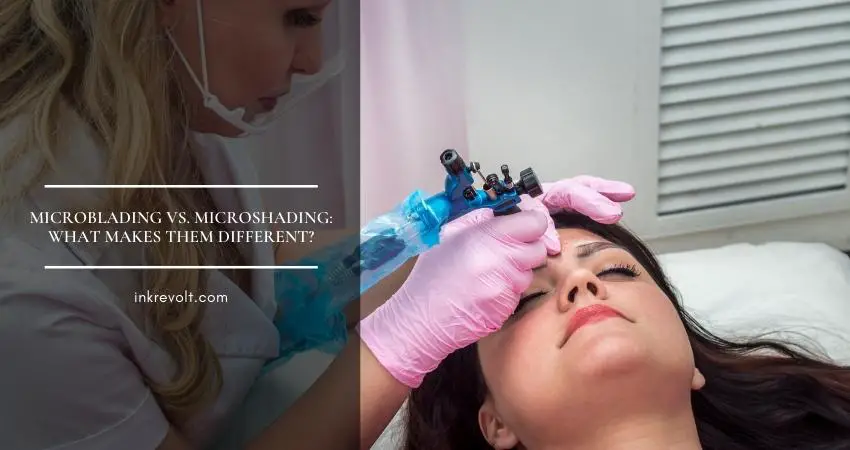Microblading vs. Microshading: What Makes Them Different?
The eyebrows have become a crucial factor in modern beauty dynamics. If you ignore them, you will never get that on-fleek look that will turn heads wherever you go. That’s why microblading has become such a trendy cosmetic procedure lately. It can beautifully redefine your eyebrows. But microblading isn’t your only option for improving your brow game.
Microshading has emerged as a great alternative to microblading. Sometimes people mistake them for being the same. While both of them offer beautiful eyebrows, microshading and microblading adopt different strategies to reach their goal.
What sets these two eyebrow treatments apart? Let’s find out.
What Is Microblading And MicroShading?

Microblading
Microblading is an eyebrow beautification technique that involves injecting pigment beneath the skin along the eyebrow lines. The end product is a thicker set of eyebrows that closely resemble natural eyebrow hair. A microblading artist can reshape the eyebrows to your liking, but it will only last about 12 to 18 months.
Microshading
Instead of drawing hair-like strokes, a microshading artist will leave a series of microscopic dots on your eyebrow skin using a sterilized needle. So, you will achieve a powdery eyebrow style in the end. Like microblading, microshading is a semipermanent process as well. You can expect the eyebrows to last for two years.
What Is The Difference Between Microblading And Microshading?
Now that we have given you the Cliff’s Note edition of microblading vs. microshading let’s dig a bit deeper. We will try to explain in more detail how microblading and microshading vary from each other. What fundamental differences draw the line between these two highly popular treatments?
Appearance
Microblading appears perfectly natural as if your brows have been dense since you were born, whereas microshading looks like brow powder. Microshading doesn’t have the natural feel of microbladed eyes, but it doesn’t look overly artificial as well. You can consider microshading as the middle ground between natural and powdered brows.
Procedure
Microblading is a hands-only approach. You might have heard about a machine-done microblading procedure, but it produces slightly different results. Therefore, it is known by a different name-nanoblading. For perfect microblading, there is no alternative to an artist patiently drawing on your skin.
Microshading can be done both ways. You can choose to go to an artist who will take the time and microshade your brows. Alternatively, you can get your eyebrows microshaded with a machine. Machine microshading can complete the process much faster, but going too fast could be painful. So, make sure the machine is set at moderate speed settings.
Durability
Both microshading and microblading are semi-permanent procedures. But, when it comes to durability, microshading has the upper hand. While microblading usually fades away within a year and a half, microshading can last for two years. The powdery brows tend to last longer than the fine hair strokes microblading artists draw.
Effectiveness On Oily Skin
Microblading works well on all skin types other than oily skin. The oils that come through the skin dilute the microblading pigment and tend to spread the color out over time. Microshading does not have this problem since the pigment gets deeper into the skin and has more opportunity to settle. So, oily skin can’t adversely affect microshading.
Which Is Better Microblading Or Microshading?
Microblading and microshading are similar in the sense that they are both semi-permanent eyebrow makeup procedures. But, they style your eyebrows in different ways. Through microblading, you can reach the closest to a natural look. If you want fuller brows without a makeup look, microblading should be your number one choice.
Microshading, on the other hand, creates more of a shadowy look. The objective is not to hide that you have undergone an eyebrow procedure but to flaunt it and dazzle the world. The misty appearance that microshading can give you will make you the focal point of any party. If you want a constant glamorous look, microshading makes more sense for you.
You also have to consider the nature of your skin. Microshading is excellent for all skin types because of its deeper skin penetration. Unfortunately, we can’t say the same for microblading. If you have oily skin, microblading will be costlier for you. Since oily skin doesn’t retain the ink well, you will have to spend more on touch-up sessions.
Microshading and microblading both have their individual advantages and disadvantages. Is there a way to combine both and enjoy the best of both worlds? Thankfully, there is. You can microblade a portion of your eyebrows and microshade the rest. This particular approach is known as “hybrid brows.”
The first third of the brow is filled in with hair-like strokes (microblading), while the latter third is filled in with shading (microshading). It is fantastic for creating a blend of natural hairs at the brow’s front and a more defined, powdered appearance towards the arch and tail. Hybrid brows, aka combo brows, offer a more balanced look.
Final Thoughts
Microblading and microshading are different tools in an esthetician’s arsenal that you can take advantage of to get the eyebrow look you want. You can pick any one of these two and enjoy their respective benefits.
Or, you can pair them up and exploit their best features. Before you proceed, consider the pros and cons so that you can choose the procedure that suits you best.
